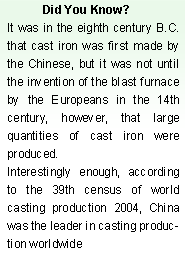Consider the casting process at 645 B.C, the first traces of the Sand Molding was found. Now consider the state-of-the-art Electromagnetic casting process. Truly, the Casting process has traversed a long path and impacted human civilization for nearly five millennia. With technological advances, metal casting is playing a greater role in our everyday lives and is more essential than it has ever been.
 Selecting the Right Metal Casting Process
Selecting the Right Metal Casting Process
- For any Metal Casting Process, selection of right alloy, size, shape, thickness, tolerance, texture, and weight, is very vital.
- Special requirements such as, magnetism, corrosion, stress distribution also influence the choice of the Metal Casting Process.
- Views of the Tooling Designer; Foundry / Machine House needs, customer's exact product requirements, and secondary operations like painting, must be taken care of before selecting the appropriate Metal Casting Process.
- Tool cost.
- Economics of machining versus process costs.
- Adequate protection / packaging, shipping constraints, regulations of the final components, weights and shelf life of protective coatings also play their part in the Metal Casting process.
The Metal Casting or just Casting process may be divided into two groups:
Hot Forming Process
Examples are Centrifugal casting, Extrusion, Forging, Full mold casting, Investment casting, Permanent or Gravity Die casting, Plaster mold casting, Sand Casting, Shell Mold casting. The method to be used depends upon the nature of the products to be cast.
Cold Forming Process
Examples are Squeeze casting, Pressure die casting, Gravity die casting, Burnishing, Coining, Cold forging, Hubbing, Impact Extrusion, Peening, Sizing, Thread rolling.
Comparative Advantages, Disadvantages and Applications for Various Casting Methods :
| Sand Casting |
| Advantages |
Disadvantages |
Recommended
Application |
|
Least Expensive in small quantities (less than 100)
Ferrous and non - ferrous metals may be cast
Possible to cast very large parts.
• Least expensive tooling |
Dimensional accuracy inferior to other processes, requires larger tolerances
Castings usually exceed calculated weight
Surface finish of ferrous castings usually exceeds 125 RMS |
Use when strength/weight ratio permits
Tolerances, surface finish and low machining cost does not warrant a more expensive process |
| Permanent
and Semi-permanent Mold Casting |
|
Less expensive than Investment or Die Castings
Dimensional Tolerances closer than Sand Castings
Castings are dense and pressure tight |
Only non-ferrous metals may be cast by this process
Less competitive with Sand Cast process when three or more sand cores are required
Higher tooling cost than Sand Cast |
Use when process recommended for parts subjected to
hydrostatic pressure
Ideal for parts having low profile, no cores and quantities in
excess of 300 |
| Plaster
Cast |
|
Smooth "As Cast" finish (25 RMS)
Closer dimensional tolerance than Sand Cast
• Intricate shapes and fine details including thinner "As Cast" walls are possible
• Large parts cost less to cast than by Investment process |
More costly than Sand or Permanent Mold-Casting
Limited number of sources
Requires minimum of 1 deg. draft |
Use when parts require smooth "As Cast" surface
finish and closer tolerances than possible with Sand or Permanent Mold Processes |
| Investment Cast |
|
Close dimensional tolerance
Complex shape, fine detail, intricate core sections and thin walls are possible
Ferrous and non-ferrous metals may be cast
As-Cast" finish (64 - 125 RMS) |
Costs are higher than Sand, Permanent Mold or Plaster process Castings |
Use when Complexity precludes use of Sand or Permanent Mold Castings
The process cost is justified through savings in machining or brazing
Weight savings justifies increased cost |
| Die
Casting |
|
Good dimensional tolerances are possible
Excellent part-part dimensional consistency
Parts require a minimal post machining |
Economical only in very large quantities due to high tool cost
Not recommended for hydrostatic pressure applications
For Castings where penetrant (die) or radiographic inspection are not required.
Difficult to guarantee minimum mechanical properties |
Use when quantity of parts justifies the high tooling cost
Parts are not structural and are subjected to hydrostatic pressure |
|
|
 Selecting the Right Metal Casting Process
Selecting the Right Metal Casting Process
